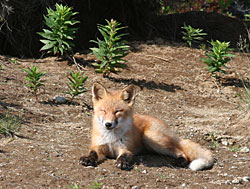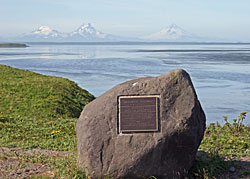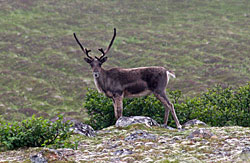Izembek National Wildlife Refuge / State Game Refuge
Wildlife Viewing

Izembek is a major migratory staging area for Pacific brant, emperor geese, and Steller’s eiders. Volcanoes, snowfields, lakes, and rivers also adorn the refuge. One of the world’s most extensive eelgrass beds is visited each autumn by more than a quarter of a million migratory birds. Besides 185 species of birds, the refuge complex is home to 23 species of land and marine mammals and 40 species of fish, including orcas and gray whales, caribou, brown bears, and the world’s only nonmigratory population of tundra swans.
Viewing Information
Waterfowl congregate at Izembek Lagoon in September and October. In late October and early November, caribou gather near the road system. Look for orcas in the fall and gray whales in the spring. River and sea otters, harbor seals, wolverines, and red foxes are visible year-round. The peak viewing season for brown bears is in July and August, though they are abundant from June through October.
Cold Bay offers access to the refuge on 40 miles of gravel road. Naturalists from the Alaska Maritime and Izembek National Wildlife Refuge will take passengers on a bus tour during the ferry stopover, but seats are limited. Even a brief drive through the refuge on a foggy day turns up a variety of wildlife. Red fox and arctic ground squirrels are common. Watch beaches and tundra for signs of bear, including scat and prints. The best opportunity to see bears from the road is May to July. Late in fall, caribou move in to the area, followed by wolves—but catching sight of the latter is rare. Arctic ground squirrels are the largest of North America’s ground squirrels and build mazes of underground burrows.

Tundra swans are common on the refuge during all seasons, but are most commonly seen from the road during the fall. Several pairs of bald eagles nest in the Sitka spruce trees that were planted at Cold Bay by the military. Young eaglets remain in the nests until August. Other birds frequently observed on the drive to Grant Point include willow ptarmigan, semipalmated plovers (which nest along the gravel margins of the road) and rock sandpipers. Songbirds that can be seen or heard along the route include savannah and golden-crowned sparrows, yellow warblers, Lapland longspurs, American pipits and common redpolls. On a clear day, the tour ends with dramatic views overlooking Shishaldin Volcano, on nearby Unimak Island, and Amak Island in the Bering Sea.
The extensive eelgrass beds in Izembek State Game Refuge's Izembek Lagoon provide habitat and feeding grounds for most of the eastern Pacific population of brant geese, half the world's population of emperor geese, and tens of thousands of cackling geese (both the Taverner’s and cackling subspecies), which migrate through Cold Bay in the fall. If you are fortunate enough to see the lagoon at low tide, you will see great expanses of bright green eelgrass. Each fall, more than 20,000 Steller’s eiders arrive to molt in the lagoon. The rich invertebrate food resources in the eelgrass provide abundant nutrients for growing new flight feathers in a short time.
More than 78,000 shorebirds pass through Izembek Lagoon in the fall, with rock sandpipers among the most common. Watch for peregrine falcons or merlins, which follow the migrating shorebirds. Careful birders may spot regular Asian visitors: juvenile sharp-tailed sandpipers, which forage along the beaches. Bald eagles are a common sight on high points overlooking the lagoon. You may also see red foxes, wolverines, mink or river otters scavenging along beaches.

Harbor seals, Steller sea lions, and sea otters are abundant in Izembek Lagoon. Harbor seals frequently haul out on sandbars and along the coast. Sea otters are frequently observed munching on crabs and other invertebrates; the lagoon is important sea otter habitat. In August 1999, biologists counted 615 of them in the lagoon. Killer, gray, and minke whales may be seen along shorelines and in Izembek Lagoon during migrations. Steller sea lions and walruses are also seen along the Bering Sea coast, though less frequently inside the lagoon.
Directions
Take a jet or ferry boat to Cold Bay. The 40-mile Cold Bay road system offers some refuge access; rent vehicles at Cold Bay. Charter flights provide access to other portions of the complex.
Contact
- Izembek National Wildlife Refuge (U.S. Fish and Wildlife Service) or (907) 532-2445
- Izembek State Game Refuge (Alaska Fish and Game)
